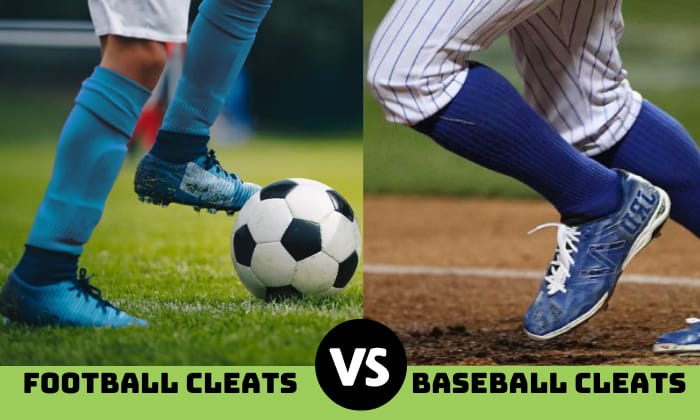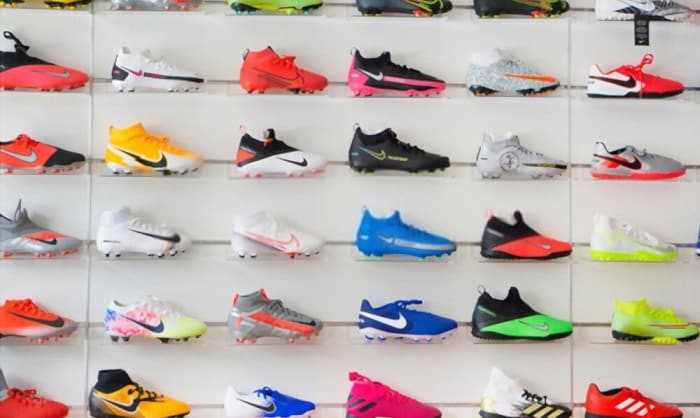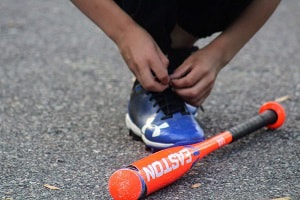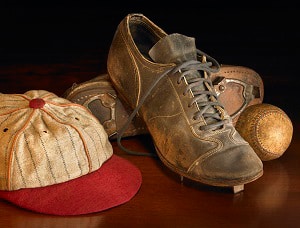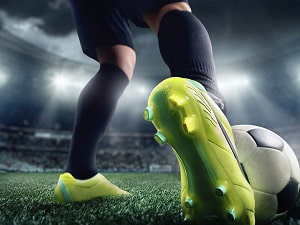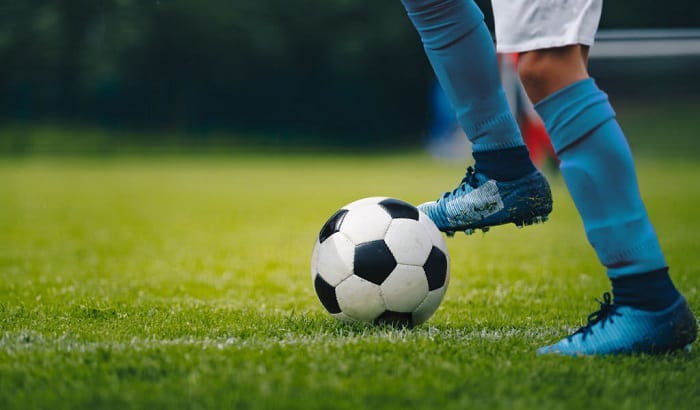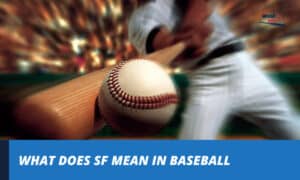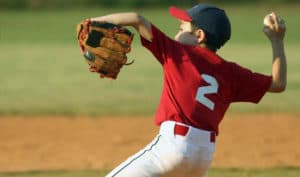Are football and baseball cleats the same? A lot of people think they are. Baseball and football cleats look quite similar at first glance. While they serve the same purpose of providing better traction on the field, there are specific distinctions between the two.
This article will look into the difference between football and baseball cleats to help you make the right choice when selecting footwear for your particular sport.
Contents
Why Cleats Are Necessary for Football and Baseball
Try wearing ordinary sneakers when playing football or baseball, and you’ll know why cleats are an essential part of the game uniform. Standard rubber shoes have flat soles, so there’s not much friction between the shoe and the surface you’re playing on.
Unlike basketball or volleyball courts with flat and solid surfaces, football and baseball fields can get muddy and slippery. Without the added friction provided by baseball and football cleats, players might slip, fall and injure themselves.
Baseball Cleats Vs Football Cleats
While the primary purpose of both baseball and football cleats is to afford players a better grip on the playing surface, each is constructed differently to serve various needs and functions. Check out what the bottom of football cleats look like, and you’ll see they’re entirely different from baseball cleats.
Here are the main differences between football cleats and baseball cleats:
1. Stud Construction
The first thing that distinguishes football cleats from baseball cleats is the size and shape of the studs on the outsoles.
- Studs on football cleats are designed for traction, so they’re generally thicker, longer, and more prominent. They also have round or oval ends and may vary in length.
- In contrast, baseball cleats have thinner, shorter, and more pointed studs. They dig into the ground better and are designed for quick takeoffs. In addition, studs on baseball cleats are typically rectangular in shape and more consistent in length.
2. Stud Material
- The studs on football cleats are made of either rubber or hard plastic. Decades ago, metal was also used but is now banned in most leagues because of its potential to cause injury amidst the frequent tackles in a football match. Metal studs also damage the playing surface.
- Baseball cleats, on the other hand, come with rubber, plastic, or metal studs. Because there’s less physical contact among players in baseball, metal studs are safe to use. Metal studs also don’t damage playing surfaces, as baseball mostly involves forward movements.
3. Stud Count and Configuration
- Football cleats have more studs than baseball cleats and will have up to 14 studs in each shoe. Most of the studs form an H pattern along the front half of the outsole, with a few more on the heel forming a square. More cleats mean better stability and balance when maneuvering the ball with the feet.
- On average, baseball cleats will have just around eight cleats—five on the front and three at the rear. The studs are distributed evenly along the edges of the front end. Those on the heel form a V-shape. This configuration enables quick takeoffs, considering baseball is a game of speed.
4. Added Toe Stud
- An extra toe stud on baseball cleats is among its most apparent distinguishing features. While baseball and football cleats come with toe guards for reinforcement and added protection from impact, baseball cleats have that extra sharp stud on the toe for better acceleration.
- You won’t find this extra toe stud on football cleats for safety reasons. Because football is more of a contact and collision sport, that extra stud might just cause serious injury when the battle for the ball becomes more combative.
5. Midsole Cushioning
- The midsole on football cleats has less padding and cushioning than baseball cleats. Because the studs on football cleats are made of rubber or plastic, there is no need for a thicker midsole that could just add to the overall weight of the shoe.
- Baseball cleats have more cushioning on the midsole, considering that thinner studs are generally sharper, and some baseball cleats come with metal studs.
The added padding also provides more flexibility which baseball players need when running from base to base.
6. Foot Support
Another difference between baseball cleats and football is the support they provide.
- Football requires players to move in all directions at all times. When moving from side to side, front to back, and vice-versa, your feet will need all the support they can get.
For this reason, football cleats are built with more supportive materials, especially around the ankles. That’s why you’ll find football cleats in a range of low, mid, or high-cut designs to guard against ankle sprains and other foot injuries.
- Movement in baseball is mainly forward. Side-to-side motions are simply occasional. That said, players don’t really need as much ankle support as football players do.
Also, the added weight of more supportive material can be detrimental in baseball, considering players require more speed and agility.
7. Weight
- Football cleats are designed primarily to provide traction, support, and protection. They need to be tough to absorb all the rigors and ordeals typical of a football game.
As a result, they tend to be on the heavier end compared to baseball cleats.
- In contrast, baseball cleats need to be lightweight so players can run faster and be more flexible and agile on the field. Any extra weight on the feet can slow them down, which is definitely a no-no in baseball.
Can You Use Football Cleats for Baseball and Baseball Cleats for Football?
Football cleats may be used in baseball but baseball cleats cannot be used in football. You may ask why but that extra toe spike on baseball cleats can pose serious danger in football games which involve a lot of body contact.
And while using football cleats in baseball is acceptable, their stud configuration is not designed for high-speed sports like baseball. They also tend to be heavier and will slow you down significantly.
All things considered, it is always best to use football cleats for football and baseball cleats for baseball for optimum performance on the field.
3 Benefits of Baseball and Football Cleats
Both baseball and football involve a lot of running and movement. When your shoes have nothing to grip on, your knees can buckle easily.
You can also twist your ankles or slip on the ground, especially when the surface is wet and muddy.
Whether you’re practicing or competing in football or baseball leagues, there are three good reasons you should wear cleats whenever you step on the field.
1. A Good Grip on the Ground
The studs or spikes that protrude from the bottom of baseball cleats and football boots are designed to provide an extra grip on the playing surface.
They stab easily into grass, dirt, or artificial turf to deliver the needed traction.
2. Protection from Injury
Cleats also help support the feet by keeping them sturdy and stable amidst all the movement. It’s easy to twist an ankle, hurt your knee, or slip and break an arm when dribbling the ball or stealing a base in football and baseball.
A good pair of cleats can prevent all these.
3. Comfort and Performance
Comfort is key to optimum performance in the field. Both football and baseball cleats are engineered to deliver everything that’s required for hours of running, kicking, sliding and negotiating the playing field, and wearing the wrong footwear won’t put you at your best.
Conclusion
While both baseball and football cleats are designed to provide a better grip on the playing surface, football cleats are heavier. They have more studs that are round, thick, and made of rubber or plastic.
On the other hand, baseball cleats are a lot lighter with fewer studs on the outsoles. The studs are thinner and sharper and can be made of rubber, plastic, or metal.
It is essential to know the difference between football and baseball cleats lest you mistake one for the other when purchasing performance shoes for your particular sport.

A powerful swing and the ball is flying across the field, just one hit, and we might never forget the thrill it brings. I do not know about you, but I never do. Every baseball game is the chance to compete with others and cooperate with your teammate. It is among my biggest passions.



